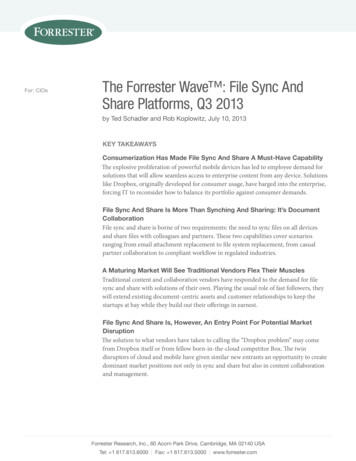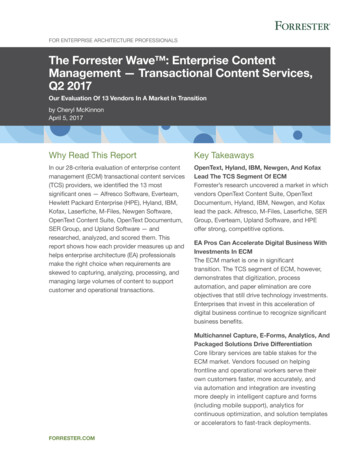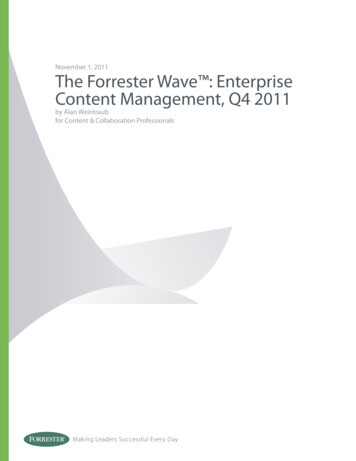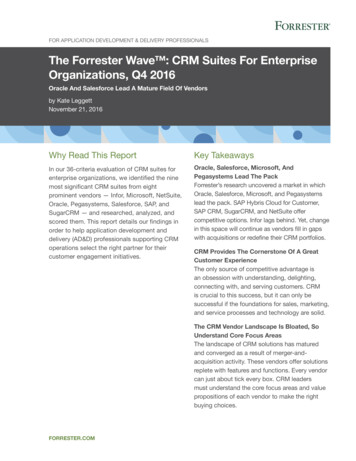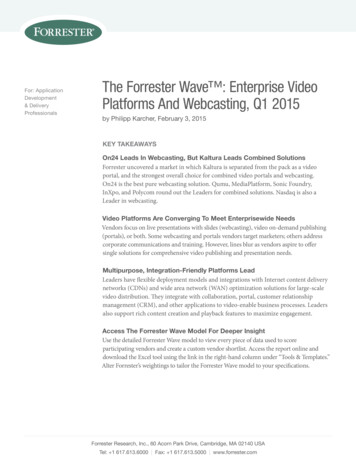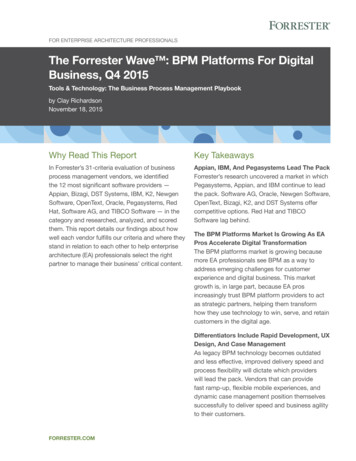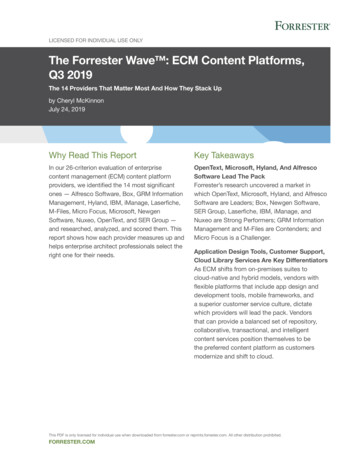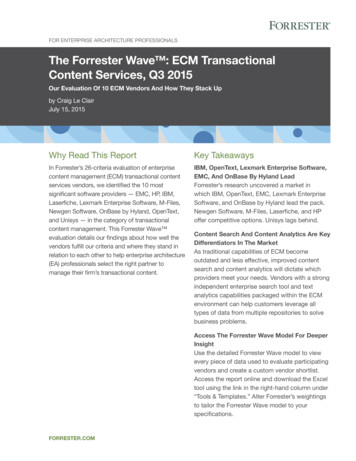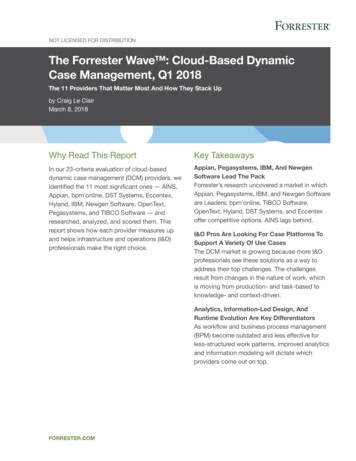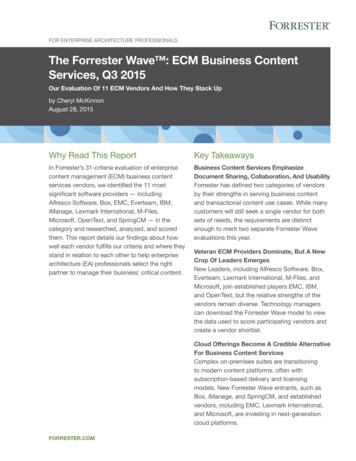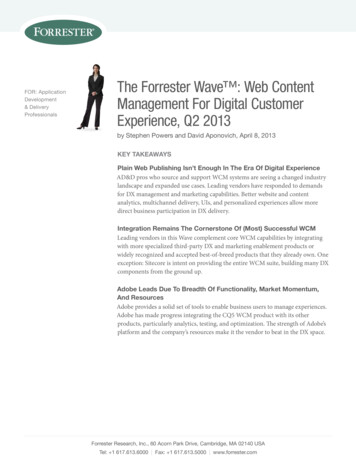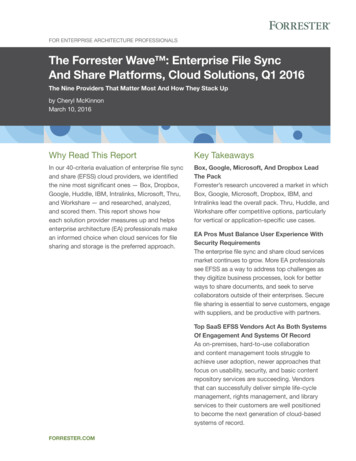
Transcription
For Enterprise Architecture ProfessionalsThe Forrester Wave : Enterprise File SyncAnd Share Platforms, Cloud Solutions, Q1 2016The Nine Providers That Matter Most And How They Stack Upby Cheryl McKinnonMarch 10, 2016Why Read This ReportKey TakeawaysIn our 40-criteria evaluation of enterprise file syncand share (EFSS) cloud providers, we identifiedthe nine most significant ones — Box, Dropbox,Google, Huddle, IBM, Intralinks, Microsoft, Thru,and Workshare — and researched, analyzed,and scored them. This report shows howeach solution provider measures up and helpsenterprise architecture (EA) professionals makean informed choice when cloud services for filesharing and storage is the preferred approach.Box, Google, Microsoft, And Dropbox LeadThe PackForrester’s research uncovered a market in whichBox, Google, Microsoft, Dropbox, IBM, andIntralinks lead the overall pack. Thru, Huddle, andWorkshare offer competitive options, particularlyfor vertical or application-specific use cases.EA Pros Must Balance User Experience WithSecurity RequirementsThe enterprise file sync and share cloud servicesmarket continues to grow. More EA professionalssee EFSS as a way to address top challenges asthey digitize business processes, look for betterways to share documents, and seek to servecollaborators outside of their enterprises. Securefile sharing is essential to serve customers, engagewith suppliers, and be productive with partners.Top SaaS EFSS Vendors Act As Both SystemsOf Engagement And Systems Of RecordAs on-premises, hard-to-use collaborationand content management tools struggle toachieve user adoption, newer approaches thatfocus on usability, security, and basic contentrepository services are succeeding. Vendorsthat can successfully deliver simple life-cyclemanagement, rights management, and libraryservices to their customers are well positionedto become the next generation of cloud-basedsystems of record.forrester.com
For Enterprise Architecture ProfessionalsThe Forrester Wave : Enterprise File Sync And Share Platforms,Cloud Solutions, Q1 2016The Nine Providers That Matter Most And How They Stack Upby Cheryl McKinnonwith Gene Leganza, Elizabeth Cullen, and Diane LynchMarch 10, 2016Table Of Contents2 Enterprise File Sync And Share Is A MarketOn The Cusp Of TransitionContent Is Shifting To The Cloud, And EFSSProviders Are Playing An Essential RoleUsability Is The Ultimate CompetitiveAdvantage For EFSS Providers3 Enterprise File Sync And Share EvaluationOverviewVendors Are Committed To Cloud, HaveA Strong Install Base, And Shape TheMarketplaceNotes & ResourcesForrester conducted product evaluations inDecember 2015, interviewed nine vendors, andsurveyed their customer references. Vendorsinclude Box, Dropbox, Google, Huddle, IBM,Intralinks, Microsoft, Thru, and Workshare.Related Research DocumentsECM In 2020: The Extended Enterprise Means ANew Vision For Enterprise Content ManagementThe Forrester Wave : ECM Business ContentServices, Q3 2015Vendor Landscape: Document-CentricCollaboration, Q4 20156 Vendor ProfilesLeadersStrong Performers11 Supplemental MaterialForrester Research, Inc., 60 Acorn Park Drive, Cambridge, MA 02140 USA 1 617-613-6000 Fax: 1 617-613-5000 forrester.com 2016 Forrester Research, Inc. Opinions reflect judgment at the time and are subject to change. Forrester ,Technographics , Forrester Wave, RoleView, TechRadar, and Total Economic Impact are trademarks of ForresterResearch, Inc. All other trademarks are the property of their respective companies. Unauthorized copying ordistributing is a violation of copyright law. Citations@forrester.com or 1 866-367-7378
For Enterprise Architecture ProfessionalsMarch 10, 2016The Forrester Wave : Enterprise File Sync And Share Platforms, Cloud Solutions, Q1 2016The Nine Providers That Matter Most And How They Stack UpEnterprise File Sync And Share Is A Market On The Cusp Of TransitionEnterprise file sync and share is firmly entrenched inside the enterprise, and technology managementbuyers no longer view it as a primarily consumer-driven technology. The broader market, however,is crowded with a multitude of vendors offering relatively comparable options. For 2016, Forresterhas segmented the most relevant EFSS vendors into two groups: first, products that are nativecloud-based software-as-a-service (SaaS) offerings, and second, products that target hybrid cloudor on-premises deployments. Cloud-native EFSS providers are investing in capabilities that makethem contenders for tomorrow’s systems of record for corporate content. EFSS solutions addressingthe hybrid and/or on-premises use cases focus on delivering secure connectors to existing contentapplications or storage locations. Thus, they allow enterprises to gain the benefits of mobile-friendly,secure file sharing technology without the burden of migrating content to yet another repository.1 EApros, when assessing EFSS requirements, must take this content repository question into account.Content Is Shifting To The Cloud, And EFSS Providers Are Playing An Essential RoleEFSS cloud vendors have the opportunity to serve not only as collaborative systems of engagementacross teams and companies but also as primary systems of record. Enterprises are accelerating theirmoves to cloud for content management and collaboration requirements. This means:›› EFSS cloud offerings already compete with ECM providers. Enterprise content management(ECM) is currently an approximately 8 billion market that is under pressure as cloud alternativesemerge and traditional vendors struggle to port legacy offerings to managed services.2 Overall,EFSS cloud vendors are ahead of these vendors in crafting the next generation of true software-asa-service (SaaS) content management and collaboration services.3›› By 2018, 80% of enterprises plan to use SaaS for some or all content services. Forrester’sdata shows that a high proportion of firms plan to meet all or some of their enterprise contentmanagement requirements with SaaS over the next two years.4 As the leading EFSS cloudproviders enhance key capabilities such as highly scalable repository services, metadata, search,task or workflow management, simple retention rules, and auditing, EFSS cloud providers canaddress a chunk of this market.›› The EFSS hybrid solution providers are also important to assess. Other key vendors in the broadEFSS market offer a mix of hybrid, cloud, and on-premises deployment options. While categorizedas hybrid providers in Forrester’s market segmentation, products such as Citrix ShareFile, Egnyte,and Syncplicity also offer complete cloud solutions for application delivery, content, and metadatamanagement, in addition to hybrid options. These alternate products offer compelling approachesfor firms still transitioning to cloud services for content storage or management. 2016 Forrester Research, Inc. Unauthorized copying or distributing is a violation of copyright law.Citations@forrester.com or 1 866-367-73782
For Enterprise Architecture ProfessionalsMarch 10, 2016The Forrester Wave : Enterprise File Sync And Share Platforms, Cloud Solutions, Q1 2016The Nine Providers That Matter Most And How They Stack UpUsability Is The Ultimate Competitive Advantage For EFSS ProvidersSuccessful EFSS deployments are driven primarily by how users embrace the tool. The leading EFSSproviders in this evaluation benefit from their multitenant, SaaS deployment models. Vendors are ableto glean insights into how users engage with the applications and use that data to drive their roadmaps and user interface evolution. This means:›› Customers must view ease-of-use and fit for the mobile workforce as key criteria. A commontheme in both the customer reference survey for this evaluation and client inquiry calls withForrester is that enterprise buyers focus on usability as a top consideration during vendor selection.Steering busy information workers to a corporately sanctioned offering rather than to self-provisionor freemium editions is successful only when the approved tool meets or exceeds the usabilitystandards of other alternatives.›› Vendors with high customer satisfaction levels are likely to be chosen again. Even when EFSSsolutions have feature gaps in areas such as advanced security or life-cycle management, thecustomers we surveyed were very likely to reselect their existing solution providers if they viewedoverall usability positively.5›› A low barrier of adoption is key to serve the extended enterprise. EFSS providers have filleda critical gap left by traditional content management and collaboration products: the ability tosecurely and simply share files with external participants. Corporate priorities now focus onimproving customer experience and digitizing business processes, meaning that engaging criticaloutside stakeholders such as partners, suppliers, and customers with content is a key concern.EFSS providers offer the licensing models and a “no training required” experience to get externalcollaborators productive quickly and with minimal administrative efforts.Enterprise File Sync And Share Evaluation OverviewTo assess the state of the EFSS cloud market and see how the vendors stack up against each other,Forrester evaluated the strengths and weaknesses of top vendors in the marketplace. After examiningpast research, user need assessments, customer surveys, and vendor and expert interviews, wedeveloped a comprehensive set of evaluation criteria. We evaluated vendors against 40 criteria, whichwe grouped into three high-level buckets:›› Current offering. We assessed the technologies based on the breadth of the tool set, withparticular emphasis on usability, security, and support for basic content repository services. Wesurveyed customers to get firsthand observation on the strength of particular capabilities andtested each vendor’s mobile app with at least one large shared file.›› Strategy. EFSS cloud vendors must show coherent strategies to help their customers share andmanage content in the cloud. We assessed vendors on strategies for pricing models, APIs, andoverall technology direction. 2016 Forrester Research, Inc. Unauthorized copying or distributing is a violation of copyright law.Citations@forrester.com or 1 866-367-73783
For Enterprise Architecture ProfessionalsMarch 10, 2016The Forrester Wave : Enterprise File Sync And Share Platforms, Cloud Solutions, Q1 2016The Nine Providers That Matter Most And How They Stack Up›› Market presence. We evaluated each vendor based on its current customer base, size of its EFSScloud revenue, geographic presence, and vertical focus. We also considered the level of interest inthe vendor based on the volume of inquiries from Forrester clients on the product.Vendors Are Committed To Cloud, Have A Strong Install Base, And Shape The MarketplaceForrester included nine vendors in the assessment: Box, Dropbox, Google, Huddle, IBM, Intralinks,Microsoft, Thru, and Workshare. Each of these vendors has a strong current EFSS cloud offering andactively markets its tool as a standalone solution. We selected vendors based on the following criteria(see Figure 1):›› A dedicated road map and go-to-market strategy focused on SaaS EFSS. Each vendordemonstrated that cloud was the predominant model for delivery of its EFSS technology and that itwas investing in cloud-based content repository services.›› Leadership in the EFSS market. Selected vendors demonstrated the ability to shape thedirection of the market, whether through innovative delivery models, technology leadership, or theirdominant market presence.›› A proven install base among enterprise customers. Vendors demonstrated revenues of over 10million with their EFSS cloud product offerings or had a minimum of 350 paying enterprise customers. 2016 Forrester Research, Inc. Unauthorized copying or distributing is a violation of copyright law.Citations@forrester.com or 1 866-367-73784
For Enterprise Architecture ProfessionalsMarch 10, 2016The Forrester Wave : Enterprise File Sync And Share Platforms, Cloud Solutions, Q1 2016The Nine Providers That Matter Most And How They Stack UpFIGURE 1 Evaluated Vendors: Product Information And Selection CriteriaVendorProduct evaluatedBoxBoxDropboxDropbox BusinessGoogleGoogle DriveHuddleHuddleIBMIBM Connection FilesIntralinksViaMicrosoftOneDrive for BusinessThruThruWorkshareWorkshareVendor selection criteriaA dedicated road map and go-to-market strategy focused on SaaS EFSS. Each vendordemonstrated that cloud was the predominant model for delivery of its enterprise file sync and share(EFSS) technology and that it was investing in cloud-based content repository services.Leadership in the EFSS market. Selected vendors demonstrated the ability to shape the direction ofthe market, whether through innovative delivery models, technology leadership, or their dominant marketpresence.A proven installed base among enterprise customers. Vendors demonstrated revenues of over 10million with their EFSS cloud product offerings or had a minimum of 350 paying enterprise customers. 2016 Forrester Research, Inc. Unauthorized copying or distributing is a violation of copyright law.Citations@forrester.com or 1 866-367-73785
For Enterprise Architecture ProfessionalsMarch 10, 2016The Forrester Wave : Enterprise File Sync And Share Platforms, Cloud Solutions, Q1 2016The Nine Providers That Matter Most And How They Stack UpVendor ProfilesThis evaluation of the enterprise file sync and share cloud solutions market is intended to be a startingpoint only. We encourage clients to view detailed product evaluations and adapt criteria weightings to fittheir individual needs through the Forrester Wave Excel-based vendor comparison tool (see Figure 2).FIGURE 2 Forrester Wave : Enterprise File Sync And Share, Cloud Solutions, Q1 ’16Challengers entofferingGo to Forrester.com todownload the ForresterWave tool for moredetailed productevaluations, featurecomparisons, andcustomizable rankings.Market presenceWeakWeakStrategyStrong 2016 Forrester Research, Inc. Unauthorized copying or distributing is a violation of copyright law.Citations@forrester.com or 1 866-367-73786
For Enterprise Architecture ProfessionalsMarch 10, 2016The Forrester Wave : Enterprise File Sync And Share Platforms, Cloud Solutions, Q1 2016The Nine Providers That Matter Most And How They Stack ntralinksMicrosoftThruWorkshareFIGURE 2 Forrester Wave : Enterprise File Sync And Share, Cloud Solutions, Q1 ’16 (Cont.)CURRENT OFFERINGArchitecture and repository servicesCollaboration and file sharingSecurity 2.202.703.103.40STRATEGYPricing strategyTechnology strategyMarket tractionAPI .00MARKET PRESENCECustomers and marketsRevenuePartners0%33%33%33%4.33 4.17 5.00 2.004.50 4.00 5.00 3.004.00 3.50 5.00 1.504.50 5.00 5.00 1.503.50 2.17 5.00 1.833.50 2.50 5.00 3.004.00 3.00 5.00 1.503.00 1.00 5.00 1.001.502.001.501.00All scores are based on a scale of 0 (weak) to 5 (strong).Leaders›› Box continues to push the boundaries of the EFSS market. Box, best known for its flagshipenterprise file sync and share offering, has invested in its underlying content repository services. Astrong focus on APIs makes this platform attractive to developers and architects who need to solvethe content-centric challenges of enterprises. Independent software vendors are also attractedto the Box platform, using it as their cloud-based content repository service. Box is committed tousability, mobility, and customer success. Enhanced capabilities for basic life-cycle management,legal hold, metadata, and task management position Box as a credible short-list candidate forsome ECM use cases, particularly for the management of collaborative business content. Keypartners, such as IBM, deliver Box’s content collaboration and management services to largeenterprise customers, with joint integrations to eDiscovery, case management, and multichannelcapture applications, filling some of the governance gaps in the Box offering.›› Google offers solid EFSS services, especially for very large file use cases. Google Drivedelivers high-performing file sharing and storage services, even for very large formats, such asvideo, that cross into the hundreds of gigabytes. Most other EFSS providers have file-size limitsthat could impede advanced requirements. Customers report high levels of satisfaction with mobileuse, full-text search, and overall technology innovation strategy. Uploaded image formats areautomatically processed with optical character recognition (OCR), enabling search. Collaboration 2016 Forrester Research, Inc. Unauthorized copying or distributing is a violation of copyright law.Citations@forrester.com or 1 866-367-73787
For Enterprise Architecture ProfessionalsMarch 10, 2016The Forrester Wave : Enterprise File Sync And Share Platforms, Cloud Solutions, Q1 2016The Nine Providers That Matter Most And How They Stack Upand content co-creation capabilities are strong, particularly when used in the context of GoogleApps for Work. Google is actively filling capability gaps in areas of life-cycle management andsupport for information governance requirements. In early 2016, expect to see enhanced data lossprevention (DLP) — this allows administrators to block actions on content containing sensitivedata, such as credit card strings or other personally identifiable information — and eDiscovery, withsupport for legal holds on documents.›› Microsoft shows strong momentum in the EFSS market. Interest in Microsoft OneDrive forBusiness is growing as Microsoft ramps up its road map and invests development resourcesinto making this a competitive SaaS EFSS offering. Microsoft’s cloud-first strategy with Office365 means that OneDrive for Business will continue to have an aggressive road map into 2016.Microsoft has invested in better cross-platform support, including native apps for Android and iOS,to close the feature gap with Windows clients. This is a critical area of focus, as customers havereported relatively low levels of satisfaction with current mobile capabilities. Microsoft continues toinvest in global data centers to meet requirements for data sovereignty, including new data centersin Australia, Germany, and India. Security and governance controls are also areas of investment,with DLP capabilities that can flag sensitive data or block sync on unmanaged desktop/laptops.›› Dropbox has a high-performance solution to the “Dropbox problem.” Dropbox has movedquickly to enhance its key enterprise offering, Dropbox Business, with API capabilities, nativeintegrations with key providers such as Adobe and Microsoft, and partnerships with security andeDiscovery providers, including Hewlett Packard Enterprise (HPE). A recently launched enterprisecustomer success program targets its large premium accounts. Dropbox’s cloud services supportthe speed and scale requirements of enterprises that collaborate widely on a range of file typesbetween internal and external participants. Dropbox has enhanced its real-time, multiusercollaboration capabilities. These include Dropbox Paper (for content authoring) and activitynotifications through an indicator called Dropbox badge. Enterprise customers report a high level ofsatisfaction with Dropbox, particularly in areas such as mobility and ease of learning. Governanceof sensitive content remains an area of relative weakness for Dropbox, including lack of native lifecycle management capabilities
ECM in 2020: the Extended Enterprise Means A new Vision For Enterprise Content Management the Forrester Wave : ECM Business Content services, Q3 2015 Vendor landscape: Document-Centric Collaboration, Q4 2015 For EntErprisE ArChitECturE proFEssionAls The Forrester Wave : Enterprise File Sync And S
